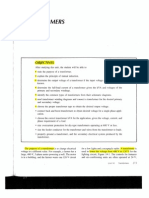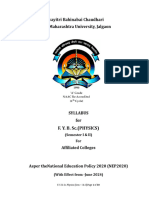Electric Machines Laboratory Report-Eee371: To Determine The Turn Ratio of A Transformer
Uploaded by
Kashif ZamanElectric Machines Laboratory Report-Eee371: To Determine The Turn Ratio of A Transformer
Uploaded by
Kashif ZamanELECTRIC MACHINES LABORATORY REPORT-EEE371
TO DETERMINE THE TURN RATIO OF A TRANSFORMER
Student Name: KASHIF ZAMAN
Registration Number: FA19-EPE-052
Student Name: Nangyal Khan
Registration Number: FA19-EPE-088
Student Name: M. Zeyad
Registration Number: FA19-EPE-085
Class/Section: EPE- B
Semester: 5th
Lab Engineer Name: Basharat Ullah
Course Teacher Name: Dr Numan Ullah
Submission Date:14/10/2021
Marks:
A P C
Department of Electrical and Computer Engineering
COMSATS University Islamabad, Abbottabad Campus
ELECTRIC MACHINES LABORATORY REPORT-EEE371
Instruction: Lab Report should include the following and maximum page limit is 6.
1. Introduction
The number of turns of the primary winding divided by the number of turns
of the secondary coil. The transformer turns ratio provides the expected operation of the
transformer and the corresponding voltage required on the secondary winding.
The transformer turns ratio provides the expected operation of the transformer and the
corresponding voltage required on the secondary winding.
If it is required a secondary voltage smaller than the primary voltage – step-down
transformer- the number of turns on the secondary must be lower than in primary,
and for step-up transformers is the other way round; when the transformer turns ratio
step-down the voltage, it steps-up the current and vice versa, so that the voltage and
current ratio of an ideal transformer is directly related to the turns ratio.
Figure 1: Stepdown Transformer with no load (Simulink model)
Department of Electrical and Computer Engineering
COMSATS University Islamabad, Abbottabad Campus
ELECTRIC MACHINES LABORATORY REPORT-EEE371
Figure 2: Stepup Transformer with load (Simulink model)
S. No V1 V2 a=V1/V2
1. 220V 12V 18.33V
2. 12V 220V 0.054V
3.
2. Operation
First of all in this lab we connect AC Voltage source(220v) Connect with stepdown
transformer with output voltage then it to scope and input voltage with AC. So we
connect input voltage with RMS then It to Display while RMS With output voltage with
display Finally we set the value of stepdown transformer as well as stepup transformer.
In Stepup transformer We connect it with resistance (12ohm) as shown in the figure 1
and 2.
3. Results and Discussion
Department of Electrical and Computer Engineering
COMSATS University Islamabad, Abbottabad Campus
ELECTRIC MACHINES LABORATORY REPORT-EEE371
Figure 1: Transformer Turn Ratio Test (Scope Result)
I in this result we gives it from the stepdown transformer and we change the coloure of result by style in
the result.
Figure 2: Transformer Turn Ratio Test (Scope Result)
Stepup transformer result
4. Conclusion
Department of Electrical and Computer Engineering
COMSATS University Islamabad, Abbottabad Campus
ELECTRIC MACHINES LABORATORY REPORT-EEE371
We know that a transformer is a static electrical machine which transfers AC electrical
power from one circuit to the other circuit at the constant frequency, but the voltage level
can be altered that means voltage can be increased or decreased according to the
requirement. Transformers are electrical devices consisting of two or more coils of wire
used to transfer electrical energy by means of a changing magnetic field. A transformer is
built to transfer the energy from one circuit into another circuit by way of magnetic
coupling. An alternating current creates a magnetic flux in the core on its way through the
first winding, inducing the voltage in the others. It can convert high and low voltages; it
cannot convert AC to DC
Department of Electrical and Computer Engineering
COMSATS University Islamabad, Abbottabad Campus
You might also like
- Experiment 4: Transformer: Circuit ModelNo ratings yetExperiment 4: Transformer: Circuit Model10 pages
- Irfan Munir: Name: Roll No: 15CE25 Lab Instructor's Signature:........... Date...................No ratings yetIrfan Munir: Name: Roll No: 15CE25 Lab Instructor's Signature:........... Date...................3 pages
- Parallel Driving of Synchronous GeneratorNo ratings yetParallel Driving of Synchronous Generator7 pages
- Experiment 1.: Aim: Determination of Transformer Equivalent Circuit From Open Circuit TheoryNo ratings yetExperiment 1.: Aim: Determination of Transformer Equivalent Circuit From Open Circuit Theory7 pages
- Transformer XII physics investigatory project (1)No ratings yetTransformer XII physics investigatory project (1)13 pages
- Transformer: Disediakan Oleh: Siti Fatimah Binti Mohd Jamil100% (1)Transformer: Disediakan Oleh: Siti Fatimah Binti Mohd Jamil39 pages
- Rauzela Bantu 215170180 Machines 2 Practical 1 MR Mbebe Single Phase TransfomerNo ratings yetRauzela Bantu 215170180 Machines 2 Practical 1 MR Mbebe Single Phase Transfomer6 pages
- Electrical Engineering Interview Interview Questions100% (1)Electrical Engineering Interview Interview Questions18 pages
- Experiment 2 Magnetizing Characteristics of DC Generator: Preliminary StudiesNo ratings yetExperiment 2 Magnetizing Characteristics of DC Generator: Preliminary Studies3 pages
- Ecgr2156 Experiment 5 Principles of Transformer Operation BNo ratings yetEcgr2156 Experiment 5 Principles of Transformer Operation B7 pages
- Electrical Machines Chapter 2.4 Auto TransformersNo ratings yetElectrical Machines Chapter 2.4 Auto Transformers6 pages
- Machine Based Experiments Lab Report-1 Name: Karthickeien E BY: CH - EN.U4CCE21024 Group: A TopicNo ratings yetMachine Based Experiments Lab Report-1 Name: Karthickeien E BY: CH - EN.U4CCE21024 Group: A Topic14 pages
- Load Test of Single Phase Transformer Phase: Expt. No: DateNo ratings yetLoad Test of Single Phase Transformer Phase: Expt. No: Date11 pages
- Electric Machines EEE241 LAB Report#2: Name Registration Number Teacher Date of SubmissionNo ratings yetElectric Machines EEE241 LAB Report#2: Name Registration Number Teacher Date of Submission13 pages
- Voltmeter Usage: Self-Learning Module Lab 01:basic Concepts and Test EquipmentNo ratings yetVoltmeter Usage: Self-Learning Module Lab 01:basic Concepts and Test Equipment15 pages
- Diagnostic Test in Mathematics 5 2022 2023No ratings yetDiagnostic Test in Mathematics 5 2022 20233 pages
- Astm D1709-16ae1 Standard Test Methods For Impact Resistance of Plastic Film by The Free-Falling Dart MethodNo ratings yetAstm D1709-16ae1 Standard Test Methods For Impact Resistance of Plastic Film by The Free-Falling Dart Method9 pages
- Motion in Two Dimensions - JEE Main 2024 January Question Bank - MathonGoNo ratings yetMotion in Two Dimensions - JEE Main 2024 January Question Bank - MathonGo2 pages
- N5 Assignments Experiment Guide Sheets LDRNo ratings yetN5 Assignments Experiment Guide Sheets LDR5 pages
- Eaton Ferrups Fe/Qfe Ups Installation Guide: Powerware SeriesNo ratings yetEaton Ferrups Fe/Qfe Ups Installation Guide: Powerware Series76 pages
- Guidelines For Application of Automated Ultrasonic Testing (AUT) Techniques, 2011No ratings yetGuidelines For Application of Automated Ultrasonic Testing (AUT) Techniques, 201130 pages
- Irfan Munir: Name: Roll No: 15CE25 Lab Instructor's Signature:........... Date...................Irfan Munir: Name: Roll No: 15CE25 Lab Instructor's Signature:........... Date...................
- Experiment 1.: Aim: Determination of Transformer Equivalent Circuit From Open Circuit TheoryExperiment 1.: Aim: Determination of Transformer Equivalent Circuit From Open Circuit Theory
- Transformer: Disediakan Oleh: Siti Fatimah Binti Mohd JamilTransformer: Disediakan Oleh: Siti Fatimah Binti Mohd Jamil
- Rauzela Bantu 215170180 Machines 2 Practical 1 MR Mbebe Single Phase TransfomerRauzela Bantu 215170180 Machines 2 Practical 1 MR Mbebe Single Phase Transfomer
- Electrical Engineering Interview Interview QuestionsElectrical Engineering Interview Interview Questions
- Experiment 2 Magnetizing Characteristics of DC Generator: Preliminary StudiesExperiment 2 Magnetizing Characteristics of DC Generator: Preliminary Studies
- Ecgr2156 Experiment 5 Principles of Transformer Operation BEcgr2156 Experiment 5 Principles of Transformer Operation B
- Machine Based Experiments Lab Report-1 Name: Karthickeien E BY: CH - EN.U4CCE21024 Group: A TopicMachine Based Experiments Lab Report-1 Name: Karthickeien E BY: CH - EN.U4CCE21024 Group: A Topic
- Load Test of Single Phase Transformer Phase: Expt. No: DateLoad Test of Single Phase Transformer Phase: Expt. No: Date
- Electric Machines EEE241 LAB Report#2: Name Registration Number Teacher Date of SubmissionElectric Machines EEE241 LAB Report#2: Name Registration Number Teacher Date of Submission
- Employability Skills: Brush up Your ElectronicsFrom EverandEmployability Skills: Brush up Your Electronics
- Voltmeter Usage: Self-Learning Module Lab 01:basic Concepts and Test EquipmentVoltmeter Usage: Self-Learning Module Lab 01:basic Concepts and Test Equipment
- Astm D1709-16ae1 Standard Test Methods For Impact Resistance of Plastic Film by The Free-Falling Dart MethodAstm D1709-16ae1 Standard Test Methods For Impact Resistance of Plastic Film by The Free-Falling Dart Method
- Motion in Two Dimensions - JEE Main 2024 January Question Bank - MathonGoMotion in Two Dimensions - JEE Main 2024 January Question Bank - MathonGo
- Eaton Ferrups Fe/Qfe Ups Installation Guide: Powerware SeriesEaton Ferrups Fe/Qfe Ups Installation Guide: Powerware Series
- Guidelines For Application of Automated Ultrasonic Testing (AUT) Techniques, 2011Guidelines For Application of Automated Ultrasonic Testing (AUT) Techniques, 2011

























































































